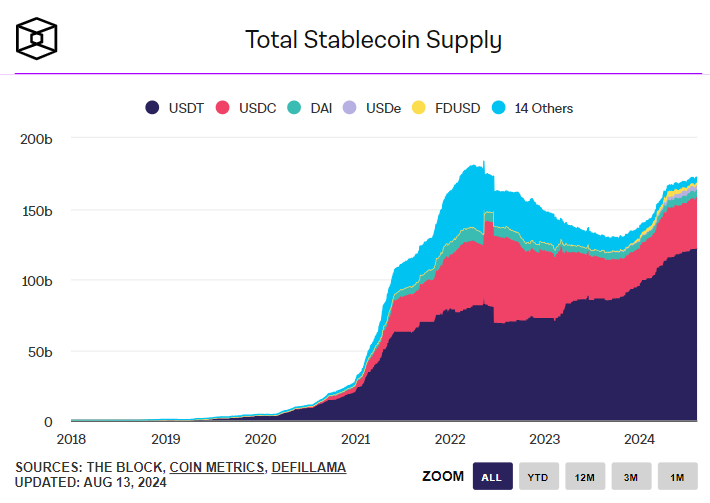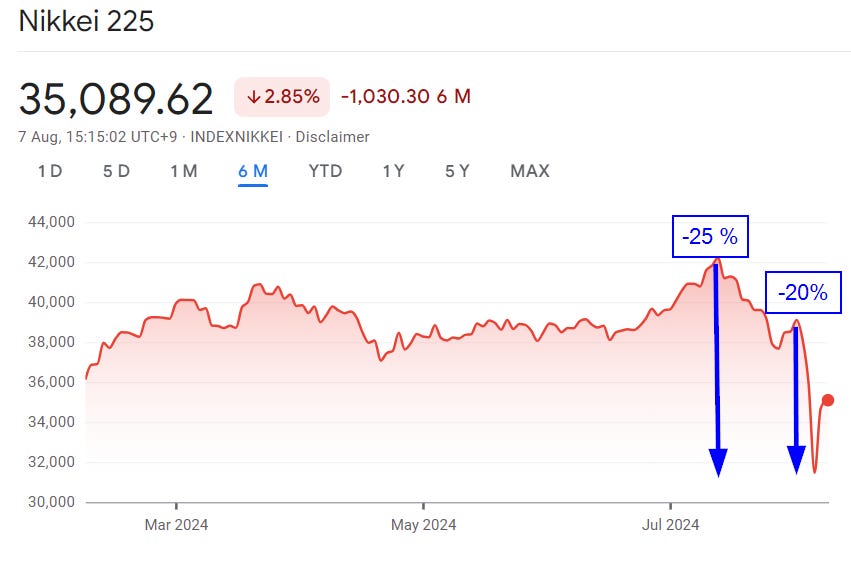Fintech: $5B in Profit with only 100 employees, Tether's money machine
How Tether and stablecoin industry has become a profit printing machine
Hi Fintech Futurists —
Today’s agenda below.
FINTECH: $5.2B in profit with only 100 employees, Tether's money machine
LONG TAKE: Analysis: Carry On? How the Yen Trade Rattled Tech, Crypto, and Fintech (link here)
CURATED UPDATES: Paytech, Neobanks, Lending, Regulation & Policy, Digital Investing
To support this writing and access our full archive of newsletters, analyses, and guides to building in Fintech & DeFi, subscribe below. No more paywalls.
Fintech Blueprint x Brainfood | Happy Hour
Are you based in London and love Fintech? We are planning a get-together for the community on September 10th in partnership with Fintech Brainfood’s Simon Taylor.
Meet us for an evening of Fintech networking, drinks, and nibbles! Would love to see you, register below.
Digital Investment & Banking Short Takes
$5.2B in profit with only 100 employees
Let's talk about Tether, the largest stablecoin with about 70% market share.
Earlier this month, Tether released its Q2 attestation report. While the report's primary purpose is to provide insight into the reserves backing the company's stablecoins, it also includes high-level performance metrics. This time, the report presented some truly staggering numbers.
Tether reported a record $5.2 billion in first-half profits. For context, U.S. Bancorp (the fifth largest U.S. bank) and PNC (the sixth largest U.S. bank) reported first-half earnings of $2.92 billion and $2.79 billion, respectively.
The numbers become even more impressive when you compare the earnings to the number of employees at each firm.
While the earnings grab the headlines, perhaps most impressive is the number of U.S. treasuries owned by the company. With $97.6 billion worth of treasuries in their reserves, if Tether were a country, it would rank as the 20th largest holder of U.S. debt.

Remember the "money printer go brrr" meme from a few years back in response to the Federal Reserve printing trillions of new money supply during Covid? It featured a banker or government official frantically printing money, with the meme critiquing the Fed's aggressive monetary policy. Those were the days when printing cash seemed limitless and money was cheap. Now, with the Fed reversing course and tightening its economic policy, that meme feels like a relic of a bygone era.
But with higher rates, we can revive it in a new context — the broader stablecoin industry.
We’ve previously covered stablecoins in detail but, as a quick refresher, stablecoins are crypto cash equivalents designed to maintain a stable value, typically pegged to a reserve asset like the US dollar. There are three main types of stablecoins: (1) fiat-backed, (2) crypto-backed, and (3) algorithmic. However, fiat-backed stablecoins dominate the market. Traditional cash and cash equivalents back these coins on a one-to-one basis.
When you get one stablecoin, the issuing company deposits one dollar into their reserve. When you redeem one stablecoin, the company withdraws one dollar from its reserve and gives it to you. Pretty simple.
While the fiat-backed model has existed for a while, recent economic conditions have made this space incredibly profitable for providers. How?
Stablecoin issuers generate most revenue by investing their cash reserves in short-term, interest-bearing instruments. Although the specific instruments may vary between issuers, they generally allow issuers to earn an essentially risk-free return. This revenue model is particularly favorable in a high-interest-rate environment. Before 2022, such an environment did not exist. However, in 2022, the U.S. began a contractionary policy, raising rates. Europe also increased interest rates for the first time in 11 years, ending a six-year negative interest rate policy. Since then, several additional rate hikes have occurred. While indicators suggest a possible rate cut on the horizon, the overall yield curve still shows a favorable near to medium-term environment.
So, what does all this mean for Tether, other players in the space, and the overall industry? At a surface level, things look great for Tether ("money printer go brrr," right?). While there is a lot of truth to that, Tether does face some risks that could impact its business.
For starters, they have long faced scrutiny and criticism over transparency. While Tether claims to be fully backed by reserves to maintain its 1:1 peg with the U.S. dollar, many have raised concerns about the adequacy and accessibility of these reserves. The company has made strides — periodic attestations discussed earlier — but critics still argue that Tether's disclosures lack the comprehensive audits necessary to instill complete confidence. That said, we’ve had Tether on the podcast previously, and the current shape of the business makes sense.
Then there is MiCA (Markets in Crypto-Assets), recently passed in the E.U. While the regulation is far from perfect, Tether has stated that, in its current form, it will not be comply with it. As a result, USDT has been delisted as a trading pair for European users on several exchanges.
Meanwhile, competition is heating up. While Tether and Circle currently dominate the stablecoin market, controlling about 90% of it, the industry's profitability has not gone unnoticed, attracting new participants on a seemingly daily basis.
And this begs the question — what will the future makeup of the stablecoin market look like? Will it resemble the credit card industry, with power consolidating to a few providers (Visa, Mastercard, Amex, Discover)? Or will the market support many players, perhaps hundreds, where every bank has its own stablecoin?
Either way, Tether seems to have taken a page from Google's book, using some of its massive profits to invest proactively beyond its core stablecoin business. This diversification strategy, if successful, could position them well in a future where their business model becomes impacted by any of the numerous threats they could face. You don’t get to make $50MM per employee in perpetuity.
👑 Related Coverage 👑
Long Take
We discuss the recent market volatility triggered by Japan's interest rate hike, which led to significant market reactions including a 25% drop in the Japanese stock market and a 10% rise in the Yen's value against the dollar.
This volatility was exacerbated by the unraveling of the yen carry trade, where investors borrow yen at low rates to invest in higher-yielding currencies like the USD. The resulting deleveraging caused widespread sell-offs in risk assets like tech stocks and cryptocurrencies. Despite the temporary shock, the long-term outlook for fintech, AI, and crypto remains positive, with potential catalysts from US macroeconomic easing and ETF demand.
Curated Updates
Here are the rest of the updates hitting our radar.
Paytech
⭐X is getting closer to launching its payment service - TechCrunch
Payoneer to Acquire Skuad for $61 Million - Finovate
Big banks are under investigation Zelle scams - Fast Company
Neobanks
ClearBank Wins License Allowing Fintech to Expand Across Europe - Bloomberg
Revolut gets UK banking licence, ending three-year wait - Reuters
Dave’s ExtraCash Advance Program Grows by 37% Amid Continued Consumer Caution - PYMNTS
Totem, a Native American-focused fintech, shuts down - Yahoo Finance
Lending
Octane secures $50m for market expansion and digital enhancements - FinTech Global
Unit secures new embedded finance partnerships with Vantage Bank and Lincoln Savings Bank - Fintech Futures
Regulation & Policy
Did regulators send warning shot at already roiled BaaS space? - BankingDive
Clair CEO backs CFPB rule proposal on EWA - BankingDive
Affirm Asks CFPB to Consider Unique Business Model of BNPL - PYMNTS
Crypto-Friendly Bank Ordered by Fed to Limit Risks From Digital Asset Clients - CoinDesk
Digital Investing
⭐Global fintech investment falls to $51.9 billion, but deal volume offers optimism - KPMG
Savvy Wealth Closes Series A Funding, Raising $26.5M - Fortune
Mexican fintech Stori to broaden offerings with fresh $212 million funding - Yahoo Finance
Bilt Rewards elevates valuation to $3.25bn with new $150m investment - FinTech Futures
🚀 Level Up
Join our Premium community and receive all the Fintech and Web3 intelligence you need to level up your career. Get access to Long Takes, archives, and special reports.













Great
🔥🔥🔥